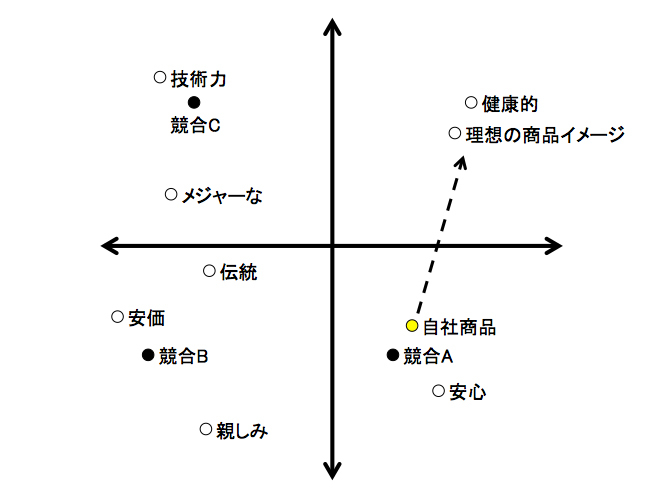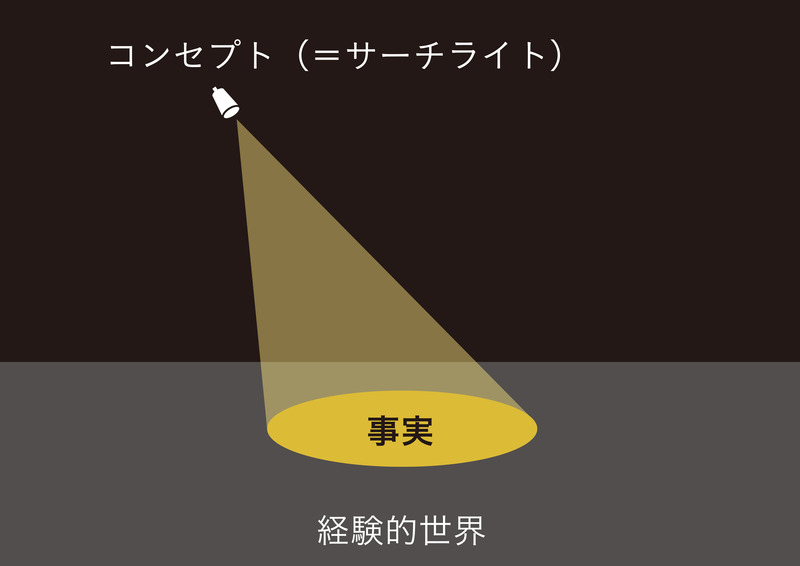I often have opportunities to propose "strategies." While organizing the background and rationale into PowerPoint materials can result in quite a few pages, the strategy itself can generally be explained on a single slide. And that single slide represents either a "map" or a "concept."

A map is typically a diagram combining two axes to show a company's position within its market. Created based on data analyzing threats and opportunities within that environment, it expresses "Which position should we take to gain a competitive advantage?" and "Where should we fight? (i.e., fighting here is safe)."
For example, it can instantly convey something like: "Analysis of our product's image showed it closely resembled major competing brands. Let's shift towards the 'healthy' direction consumers desire." Here, little attention is paid to "How do we shift in that direction? (i.e., how do we fight?)" The key is simply to become "healthy."
The "map strategy" itself lacks the "aha!" element of surprise. Therefore, when creating advertising based on this strategy, the role of expressive ideas becomes more crucial. The "map" is effective when strategists and creatives divide roles, developing strategy through objective analysis.

On the other hand, when the existing approach is no longer viable, or when a dramatically new approach is needed to change the rules of competition in the market, the "concept" can intuitively share the path forward with all stakeholders.
It's the phrase that answers "How do we fight?" However, its weakness lies in the inability to prove its validity with objective data. This becomes clear when recalling Taro Okamoto's famous declaration, "Art is an explosion."
Despite aiming for art as "the joy of living," Okamoto was troubled by a situation where only things that were skillful, beautiful, or comfortable were being valued. To solve this and propose a new perspective that would change the rules of competition, he advocated the concept (strategy) "Art is an explosion." However, if this were a strategy presentation, proving the power of "Art is an explosion" before concrete works like the "Tower of the Sun" existed would be extremely difficult. Even if you surveyed its appeal, respondents would just be baffled. A "strategy" expressed as a concept can articulate "How to fight?", but it doesn't tell you "Where to fight? (i.e., fighting here will be fine)".
The "concept strategy" itself is an "aha!" idea. When creating advertising with this strategy, while expressive ideas are certainly needed, it's crucial to properly shape the core new perspective.
Map strategy and concept strategy are fundamental frameworks to be applied appropriately depending on the situation. Ambiguity here prevents the development of genuine strategy.
 |
This is the Arab "hummus" knockoff.
|
I love cooking and wield a knife five days a week. I tackle Japanese, Chinese, French, Italian, and even Arab cuisine by finding recipes online. Blend chickpeas, tahini, olive oil, lemon, salt, and a little garlic in a mixer, and you've got an exotic sauce. Spread it on baguette or toss it into a salad.
But no matter how far I go, it always stops at being "sort of" the real thing. That's because my cooking lacks structure. It's forever stuck at the level of snacks for drunk people.
When creating a "strategy," you sprinkle in terms like target, concept, segmentation, Blue Ocean, or high-speed PDCA, and it looks "strategic." But without a "form," it won't rise above drunken ramblings.
I've rambled on a bit too much with my little theories, so next time I'll hit you with the groundbreaking story behind the birth of the Kuroge Wagyu beef cutlet.
Enjoy!





